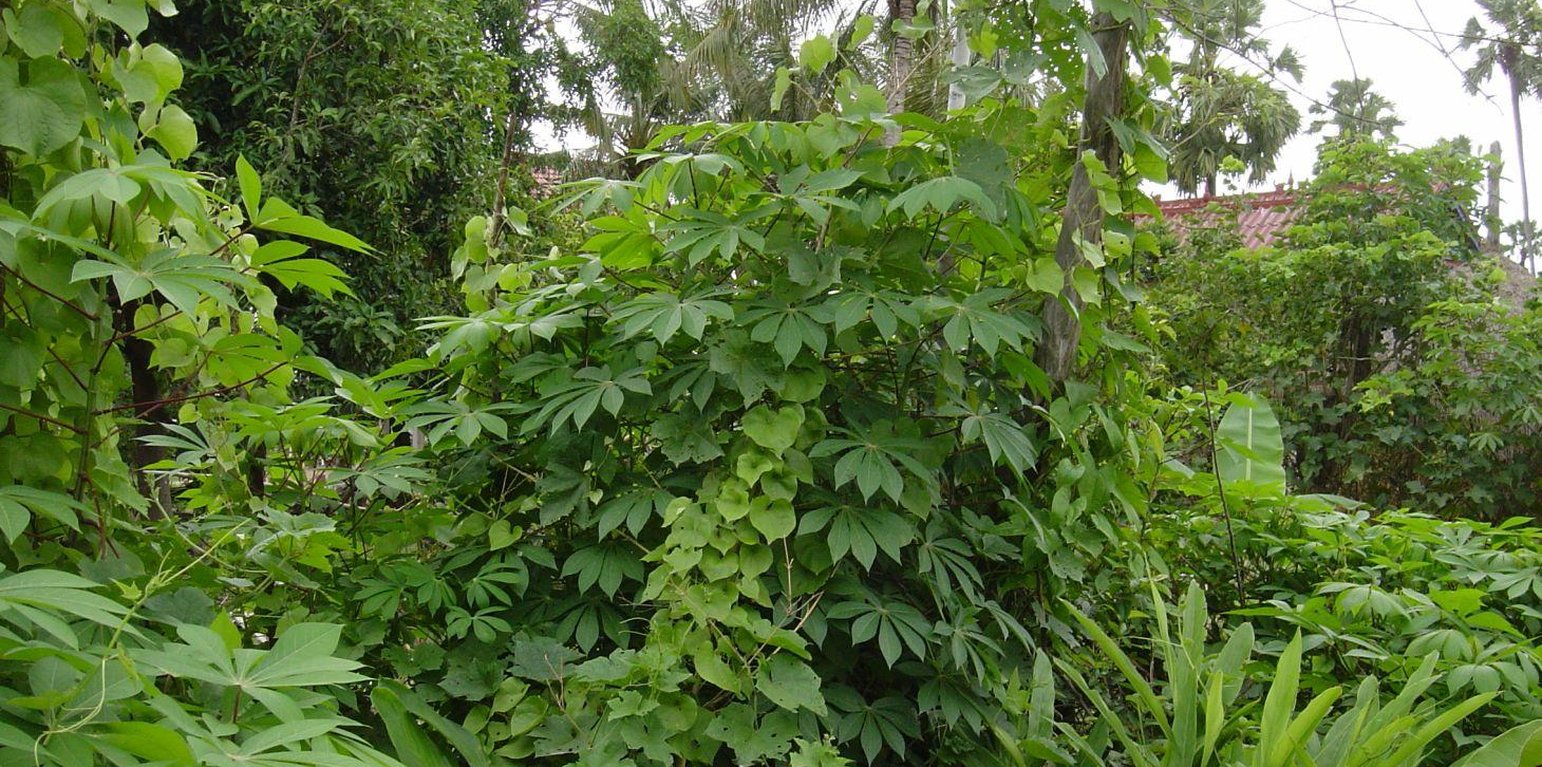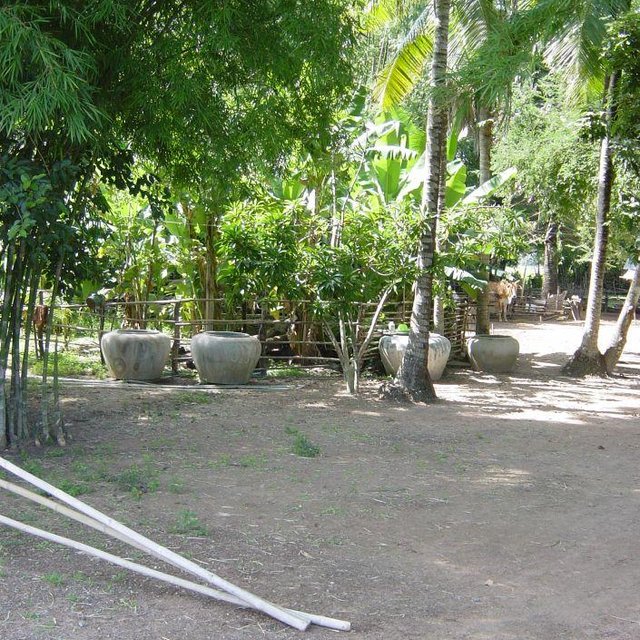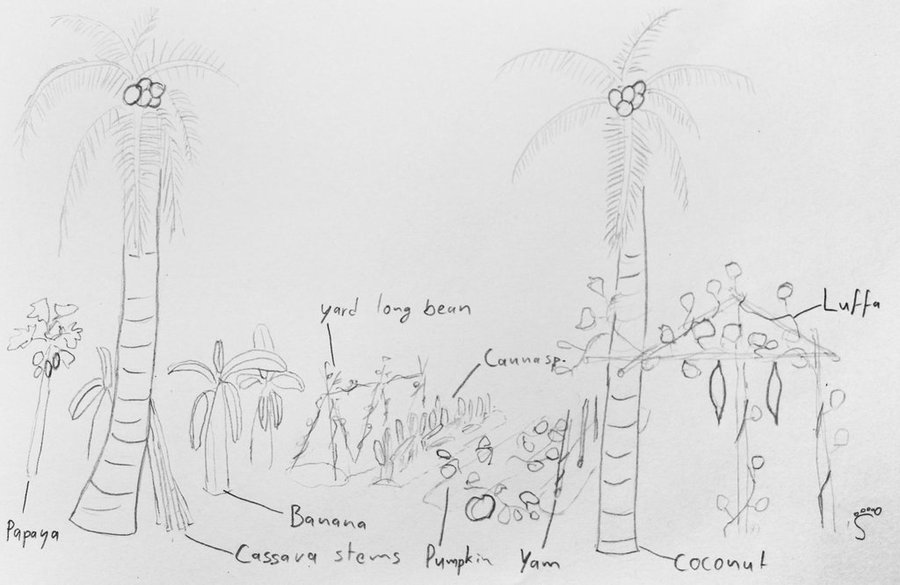



Home gardens are a traditional setting in Cambodia, where they appear around nearly each house. All the seven layers of production occur, with a tree canopy, lower trees, shrubs, herbs, a soil cover, roots and tubers as well as a climbing layer, but not all layers can be found in each garden. The overlapping production allows a high productivity on a small area, and the trees/canopy provide a comfortable microclimate for both humans and livestock. The products of the home gardens are consumed by the family, surplus is given to neighbours or sold, and provide an additional income. One or more of the crops are produced in bigger amounts to serve as a cash crop. It can be coconuts close to the city, mangoes that are processed, sugarcane or vegetables like winged beans for the market, bamboo for handicrafts or constructions. Poultry is free ranging in the home gardens, thus when short annual plants like water spinach are planted they are protected with bamboo or net fences. The poultry, mostly chicken, but as well ducks, Muscovy ducks, and others, forages in the waste and eats bugs and worms.
The home gardens are planted to produce food, to provide additional income source and assure a comfortable microclimate. Medicinal plants, as well as plants for handicrafts like bamboo, are grown in the home gardens. Due to a lack of labour availability on the farms, the gardens are only poorly maintained. Some NGOs try to implement the production of more annual crops in the home gardens, but fail due to this constraint and the fact that leafy vegetables are collected from the wild during the wet season.
When a new house is built, canopy trees like coconuts or sugar palms are planted, sometimes following a square pattern, with other trees in between. In other gardens, no pattern can be found, as trees are planted more randomly, or left growing on their own. The seedlings growing in and around trash piles are transplanted to more suitable places, sometimes seedlings from grafted varieties are bought from the market.
Mainly annual crops, like yam, are fertilized with cow manure or compost before the sowing. Due to a lack of irrigation water, most farmers only grow annuals during the wet season. During the dry season, the vegetables are bought from other provinces or countries.
The analysed area is flat (slope < 2%), tropic (dry and wet season), and the soils are mostly sandy or loamy. The soils on the fields contain little organic matter (low soil fertility, acidification, small amount of cattle, area has been deforested a long time ago) and the groundwater table is rather high (2 m below soil level during the dry season, on the surface during the wet season).
Due to climate change, the rainfalls are more erratic, temperatures rise and droughts are more recurrent. Rice is the predominant crop grown in the area, since it serves as staple food (mix subsistence and commercial activities). Rice is often grown in monocultures and harvested once a year. Once the rice is harvested (dry season), some farmer release cattle to the paddy fields to eat the straw and weeds.
As an addition to rice, most land users grow vegetable and fruits in home gardens (subsistence) and complement their income by producing handicrafts or through off-farm income / remittances from family members working in other places. Gathering of wild food (plants, animals, and mushrooms) is also of importance for the diet. The increasing migration rate (the young generation leaves the villages to work in the cities, garment industry or abroad) results in a decrease of available labour force in the area that has detrimental effects on the agricultural activities. Furthermore, the civil war in the 1970s (Khmer Rouge) led to the loss of agricultural knowledge that different NGOs try to re-establish.
Location: Kampong Chhnang, Cambodia
No. of Technology sites analysed:
Spread of the Technology: evenly spread over an area (approx. 10-100 km2)
In a permanently protected area?:
Date of implementation: more than 50 years ago (traditional)
Type of introduction







| Specify input | Unit | Quantity | Costs per Unit (n.a.) | Total costs per input (n.a.) | % of costs borne by land users |
| Labour | |||||
| Labour | 1.0 | 10.0 | 10.0 | 100.0 | |
| Equipment | |||||
| Tools | 1.0 | 20.0 | 20.0 | 100.0 | |
| Plant material | |||||
| seeds | 1.0 | 5.0 | 5.0 | 100.0 | |
| seedlings | 1.0 | 45.0 | 45.0 | 100.0 | |
| Total costs for establishment of the Technology | 80.0 | ||||
| Total costs for establishment of the Technology in USD | 80.0 | ||||
| Specify input | Unit | Quantity | Costs per Unit (n.a.) | Total costs per input (n.a.) | % of costs borne by land users |
| Labour | |||||
| labour | 1.0 | 60.0 | 60.0 | 100.0 | |
| Plant material | |||||
| seeds | 1.0 | 3.0 | 3.0 | 100.0 | |
| Total costs for maintenance of the Technology | 63.0 | ||||
| Total costs for maintenance of the Technology in USD | 63.0 | ||||
Bioremediation of groundwater.
if more perennials (trees) are planted.
Otherwise only rice is grown. Bamboo is used for handicraft.
Depending on crops. Most home garden crops have an excellent cost/benefit ratio.
Together with food collected from the wild, improves the mainly rice based dishes.
Increased income, income diversification, food security, food diversification
Bioremediaiton of groundwater.
Permanent soil cover
Nutrients from groundwater are returned to the cycle.
If the leaves are not burnt.
Bioremediation of groundwater.
Bioremediation of groundwater.